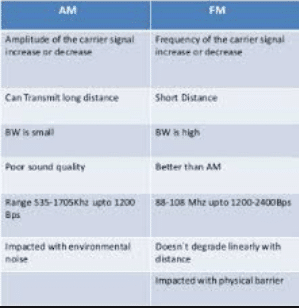Difference Between Amplitude and Frequency Modulation in Tabular Form

Basically there are three types of modulation, frequency modulation, amplitude modulation, and Phase modulation. The basic difference between amplitude and frequency modulation is that in frequency modulation audio signals change frequency of carrier wave while in amplitude modulation audio signals change the amplitude of carrier wave.
Difference between AM and FM in tabular form
| Amplitude modulation ( AM ) | Frequency modulation (FM) |
| AM stands for amplitude modulation. | FM stands for frequency modulation. |
| This method was first introduced in mid-1870. | FM was introduced in the USA in 1930 by Advin Armstrong. |
| AM has poor sound quality than FM. | FM has better sound quality than AM. |
| In AM audio signals changes the amplitude of carrier wave. | In FM, the audio signals change the frequency of a carrier wave. |
| It affects electrical interference more than FM. | FM is not affected by electrical interference as compared to AM. |
| AM has a frequency range between 540 – 1600 HZ. | FM has a frequency range of 88 – 108 MHZ. |
| It has a long-range. | It has a short-range. |
| AM systems are not immune to noise. | These systems are immune to noise. |
| In AM only carrier power and one sideband power is useful. | In FM all transmitted power is useful. |
Browse also : Modulation and its types
Amplitude Modulation(AM)
This type of modulation the amplitude of the carrier wave is increased or diminished as the amplitude of the superposing modulating signal increases and decreases.
Represents a high-frequency carrier wave of constant amplitude and frequency. Represents a ( ) or audio frequency signal of a sine waveform. The result obtained by modulating carrier waves with the modulating wave. The A.M. transmission frequencies range from 540 kHz to 1600 kHz.
Frequency Modulation (FM)
In this type of modulation, the frequency of the carrier wave is increased or diminished as the modulating signal amplitude increases or decreases but the carrier wave amplitude remains constant. The frequency of the modulated carrier wave is highest (point H) when the signal amplitude is at its maximum positive value and is at its lowest frequency (point L) when signal amplitude has maximum negative. When the signal amplitude is zero, the carrier frequency is at its normal frequency f⁰.
The F.M. transmission frequencies are much higher and range between 88 MHz to 108 MHz. The F.M. radio waves are affected less by electrical interference then A.M. radio waves and hence provide a higher quality transmission of sound. However, they have a shorter range than A.M. waves and are less able to travel around obstacles such as hills and larger buildings.
See Also: Types of modulation
Similarities between AM VS FM
- Both created by stars.
- In both processes, signals travel in the form of radio waves.
- Both types of signals are produced artificially.
- Both are affected by electrical interference.
- They have their own carrier wave frequency.
- In both systems, vibrations cause radio waves.
AM vs FM (video)
For More Information:
External source:
https://byjus.com/physics/difference-between-am-and-fm/
